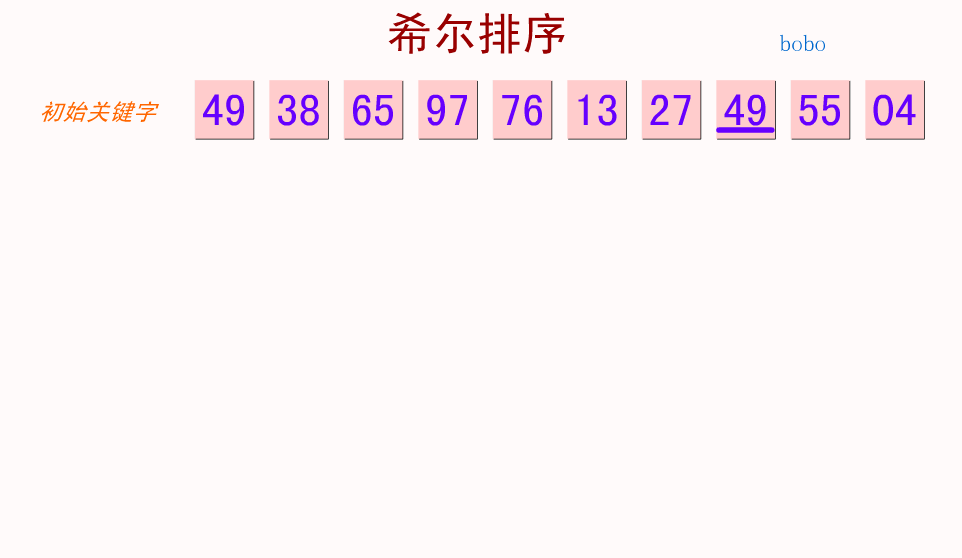我的Java开发学习之旅------>Java经典排序算法之希尔排序
一、希尔排序(Shell Sort)
希尔排序(Shell Sort)是一种插入排序算法,因D.L.Shell于1959年提出而得名。
Shell排序又称作缩小增量排序。
二、希尔排序的基本思想
希尔排序的中心思想就是:将数据进行分组,然后对每一组数据进行排序,在每一组数据都有序之后 ,就可以对所有的分组利用插入排序进行最后一次排序。这样可以显著减少交换的次数,以达到加快排序速度的目的。
希尔排序的中心思想:先取一个小于n的整数d1作为第一个增量,把文件的全部记录分成d1个组。所有距离为dl的倍数的记录放在同一个组中。先在各组内进行直接插人排序;然后,取第二个增量d2<d1重复上述的分组和排序,直至所取的增量dt=1(dt<dt-l<…<d2<d1),即所有记录放在同一组中进行直接插入排序为止。
该方法实质上是一种分组插入方法。
shell排序的算法实现:
void ShellPass(SeqList R,int d)
{//希尔排序中的一趟排序,d为当前增量
for(i=d+1;i<=n;i++) //将R[d+1..n]分别插入各组当前的有序区
if(R[i].key<R[i-d].key){
R[0]=R[i];j=i-d; //R[0]只是暂存单元,不是哨兵
do {//查找R[i]的插入位置
R[j+d];=R[j]; //后移记录
j=j-d; //查找前一记录
}while(j>0&&R[0].key<R[j].key);
R[j+d]=R[0]; //插入R[i]到正确的位置上
} //endif
} //ShellPass
void ShellSort(SeqList R)
{
int increment=n; //增量初值,不妨设n>0
do {
increment=increment/3+1; //求下一增量
ShellPass(R,increment); //一趟增量为increment的Shell插入排序
}while(increment>1)
} //ShellSort
注意:
当增量d=1时,ShellPass和InsertSort基本一致,只是由于没有哨兵而在内循环中增加了一个循环判定条件"j>0",以防下标越界。
三、希尔排序算法分析
1、增量序列的选择。
Shell排序的执行时间依赖于增量序列。好的增量序列的共同特征如下:
a.最后一个增量必须为1。
b.应该尽量避免序列中的值(尤其是相邻的值)互为倍数的情况。
有人通过大量实验给出了目前最好的结果:当n较大时,比较和移动的次数大概在n^1.25到n^1.26之间。
2、Shell排序的时间性能优于直接插入排序。
希尔排序的时间性能优于直接排序的原因如下:
a.当文件初态基本有序时,直接插入排序所需的比较和移动次数均较少。
b.当n值较小时,n和n^2的差别也较小,即直接插入排序的最好时间复杂度O(n)和最坏时间复杂度O(n^2)差别不大。
c.在希尔排序开始时增量较大,分组较多,每组记录数目少,故每组内直接插入排序较快,后来增量d(i)逐渐缩小,分组数逐渐减少,而各组的记录数目逐渐增多,但由于已经按d(i-1)做为距离拍过序,使文件较接近于有序状态,所以新的一趟排序过程也较快。因此,希尔排序在效率上较直接插入排序有较大的改进。
3、稳定性
希尔排序是不稳定的。
四、算法演练
ps:读者也可以自己打开下面的链接,自己设定要排序的数组,进行排序演练
希尔排序动画演示(http://student.zjzk.cn/course_ware/data_structure/web/flashhtml/shell.htm)
五、代码实现
public class ShellSortTest {
private static void shellSort(int[] source) {
int j;
for (int gap = source.length / 2; gap > 0; gap /= 2) {
for (int i = gap; i < source.length; i++) {
int temp = source[i];
for (j = i; j >= gap && temp < source[j - gap]; j -= gap)
source[j] = source[j - gap];
source[j] = temp;
}
System.out.print("增长序列:" + gap + " :");
printArray(source);
}
}
private static void printArray(int[] source) {
for (int i = 0; i < source.length; i++) {
System.out.print("\t" + source[i]);
}
System.out.println();
}
public static void main(String[] args) {
int source[] = new int[] {49,38,65,97,76,13,27,49,55,04 };
System.out.print("原始序列:");
printArray(source);
System.out.println("");
shellSort(source);
System.out.print("\n\n最后结果:");
printArray(source);
}
}
运行结果为:
原始序列: 49 38 65 97 76 13 27 49 55 4 增长序列:5 : 13 27 49 55 4 49 38 65 97 76 增长序列:2 : 4 27 13 49 38 55 49 65 97 76 增长序列:1 : 4 13 27 38 49 49 55 65 76 97 最后结果: 4 13 27 38 49 49 55 65 76 97
发现增长序列是5,2,1 和题目要求的5,3,1不同。通过分析要排序的文件由10个记录,10/2=5,5-2=3,3-2=1。刚好符合要求,因此将上面的代码稍作修改即可改变增长序列的值。
将shellSort(int[] source) 方法里的下面这行代码
for (int gap = source.length / 2; gap > 0; gap /= 2) {
改为:
for (int gap = source.length / 2; gap > 0; gap -= 2) {
然后重新运行程序,打印结果如下:
原始序列: 49 38 65 97 76 13 27 49 55 4 增长序列:5 : 13 27 49 55 4 49 38 65 97 76 增长序列:3 : 13 4 49 38 27 49 55 65 97 76 增长序列:1 : 4 13 27 38 49 49 55 65 76 97 最后结果: 4 13 27 38 49 49 55 65 76 97
=================================================================
如果想使用指定的增长序列来对指定的数组进行希尔排序,可以对上面的程序修改,修改后代码如下:
public class ShellSortTest2 {
/**
* 待排序的数组
*/
private int[] sources;
/**
* 数组内元素个数
*/
private int itemsNum;
/**
* 增量数组序列
*/
private int[] intervalSequence;
/**
* @param maxItems
* 数组大小
* @param intervalSequence
* 增量数组序列
*/
public ShellSortTest2(int[] source, int[] intervalSequence) {
this.sources = new int[source.length];
this.itemsNum = 0;// 还没有元素
this.intervalSequence = intervalSequence;
}
/**
* 希尔排序算法
*/
public void shellSort() {
int gap = 0;// 为增量
for (int iIntervalLength = 0; iIntervalLength < intervalSequence.length; iIntervalLength++)// 最外层循环,由增量序列元素个数决定
{
gap = intervalSequence[iIntervalLength]; // 从增量数组序列取出相应的增长序列
int innerArraySize;// 每次内部插入排序的元素个数
if (0 == itemsNum % gap) {
innerArraySize = itemsNum / gap;
} else {
innerArraySize = itemsNum / gap + 1;
}
for (int i = 0; i < gap; i++) {
int temp = 0;
int out = 0, in = 0;
if (i + (innerArraySize - 1) * gap >= itemsNum) {
innerArraySize--;
}
// 内部用插入排序
for (int j = 1; j < innerArraySize; j++) {
out = i + j * gap;
temp = sources[out];
in = out;
while (in > gap - 1 && sources[in - gap] > temp) {
sources[in] = sources[in - gap];
in = in - gap;
}
sources[in] = temp;
}
}
System.out.print("增长序列为: " + gap + " ");
this.displayArray();
}
}
/**
* 初始化待排序数组
*/
public void initArray(int[] array) {
for (int i = 0; i < array.length; i++) {
sources[i] = array[i];
}
itemsNum = array.length;
}
/**
* 显示数组内容
*/
public void displayArray() {
for (int i = 0; i < itemsNum; i++) {
System.out.print("\t" + sources[i] + " ");
}
System.out.println("\n");
}
public static void main(String[] args) {
int[] intervalSequence = { 5, 3, 1 };
int[] source = { 49, 38, 65, 97, 76, 13, 27, 49, 55, 04 };
ShellSortTest2 ss = new ShellSortTest2(source, intervalSequence);
// 初始化待排序数组
ss.initArray(source);
System.out.print("原始序列: ");
ss.displayArray();
// 希尔排序
ss.shellSort();
System.out.print("最后结果: ");
ss.displayArray();
}
}
运行结果如下:
原始序列: 49 38 65 97 76 13 27 49 55 4 增长序列为: 5 13 27 49 55 4 49 38 65 97 76 增长序列为: 3 13 4 49 38 27 49 55 65 97 76 增长序列为: 1 4 13 27 38 49 49 55 65 76 97 最后结果: 4 13 27 38 49 49 55 65 76 97
==============================================================================================
作者:欧阳鹏 欢迎转载,与人分享是进步的源泉!
转载请保留原文地址:http://blog.csdn.net/ouyang_peng
==============================================================================================


